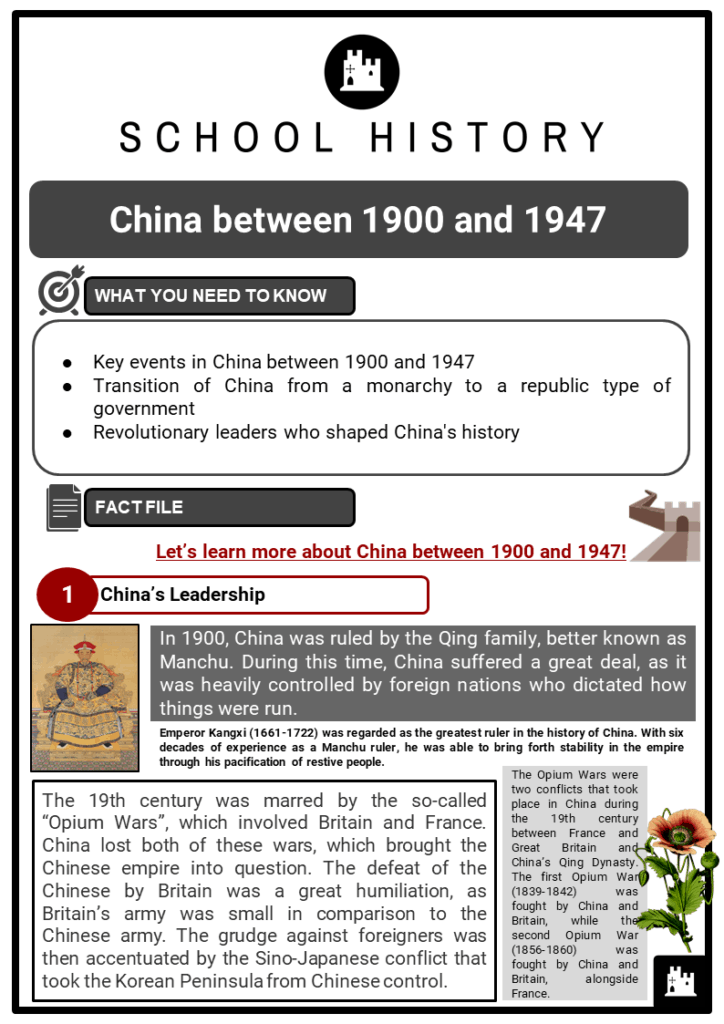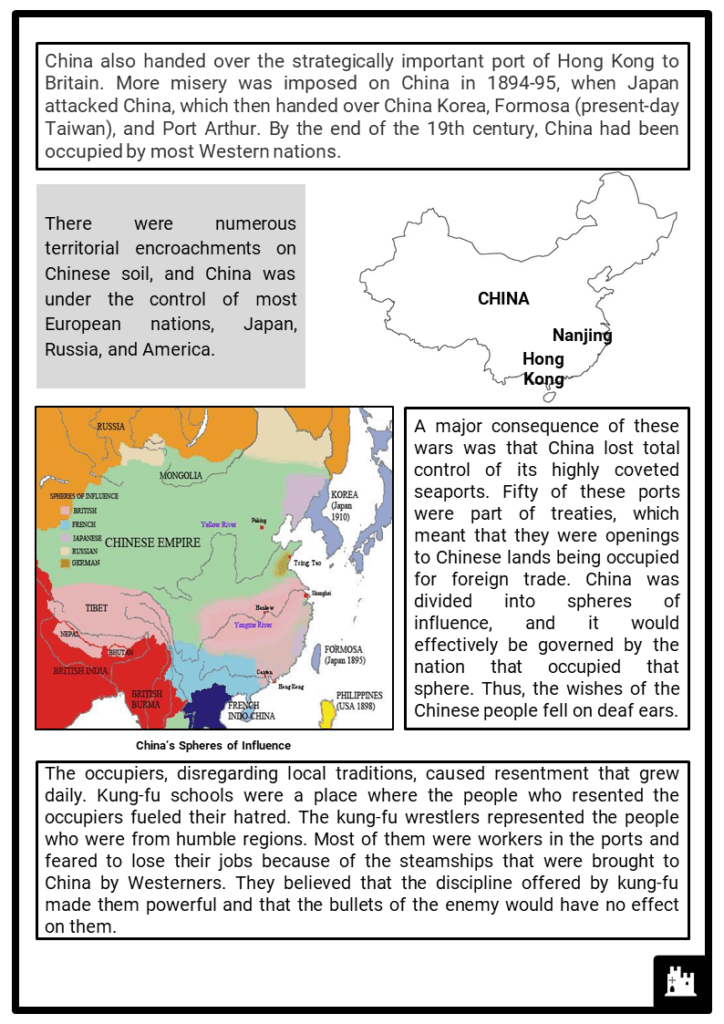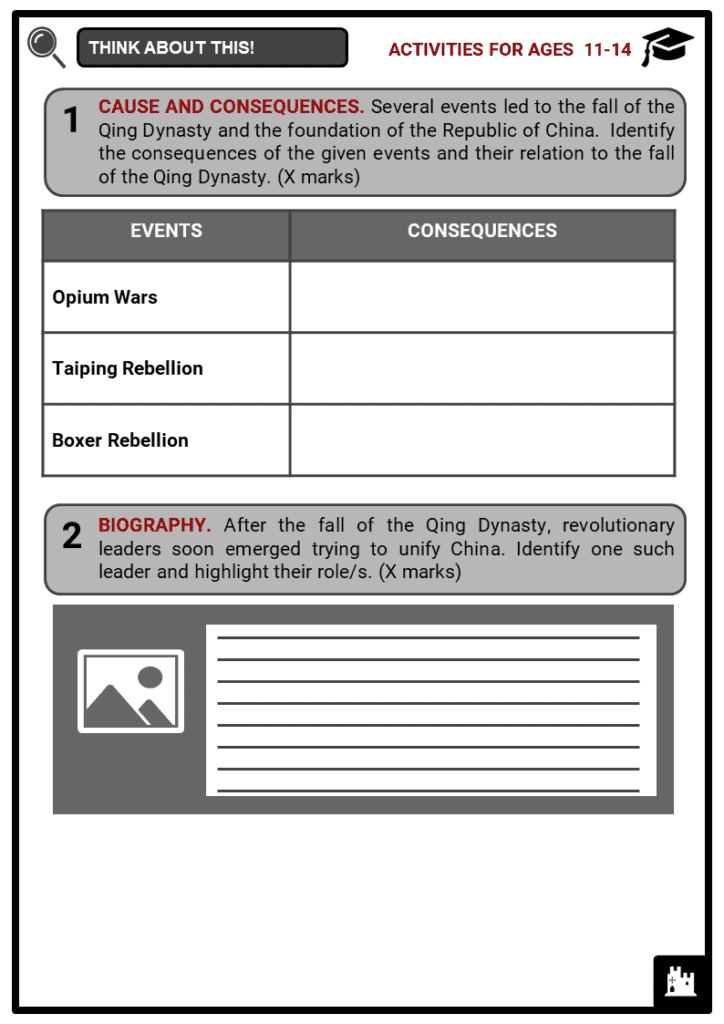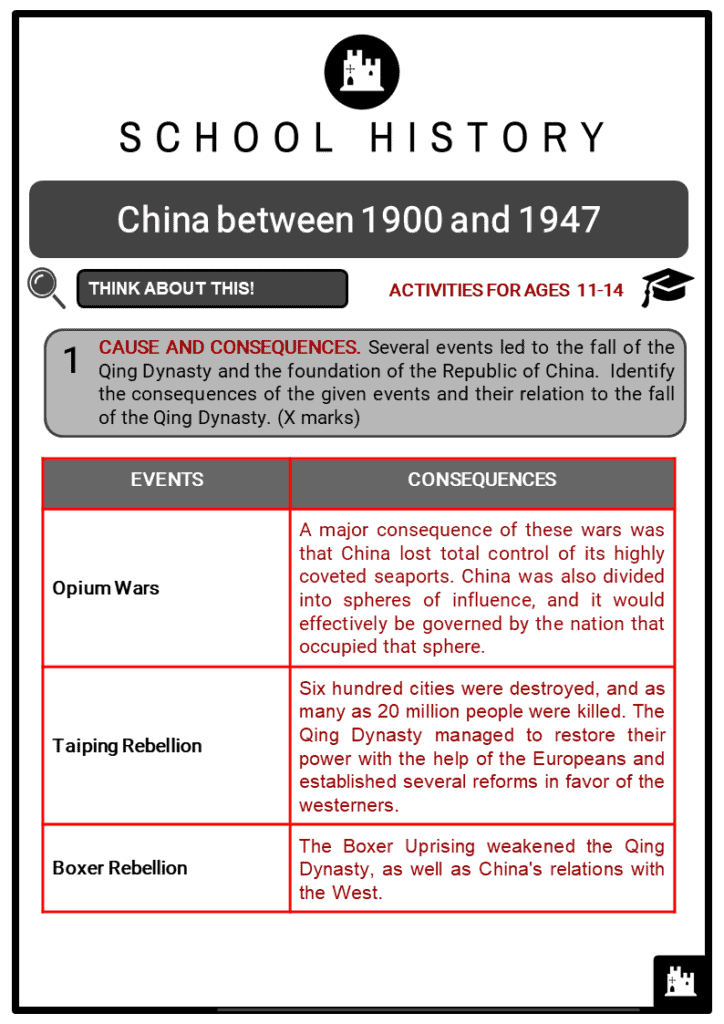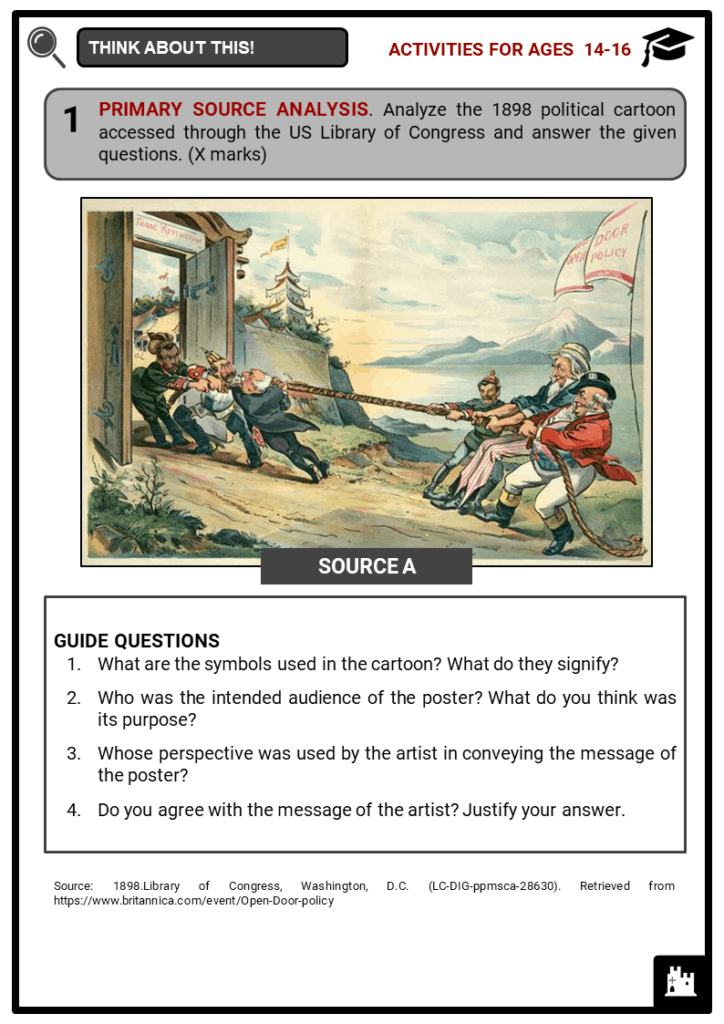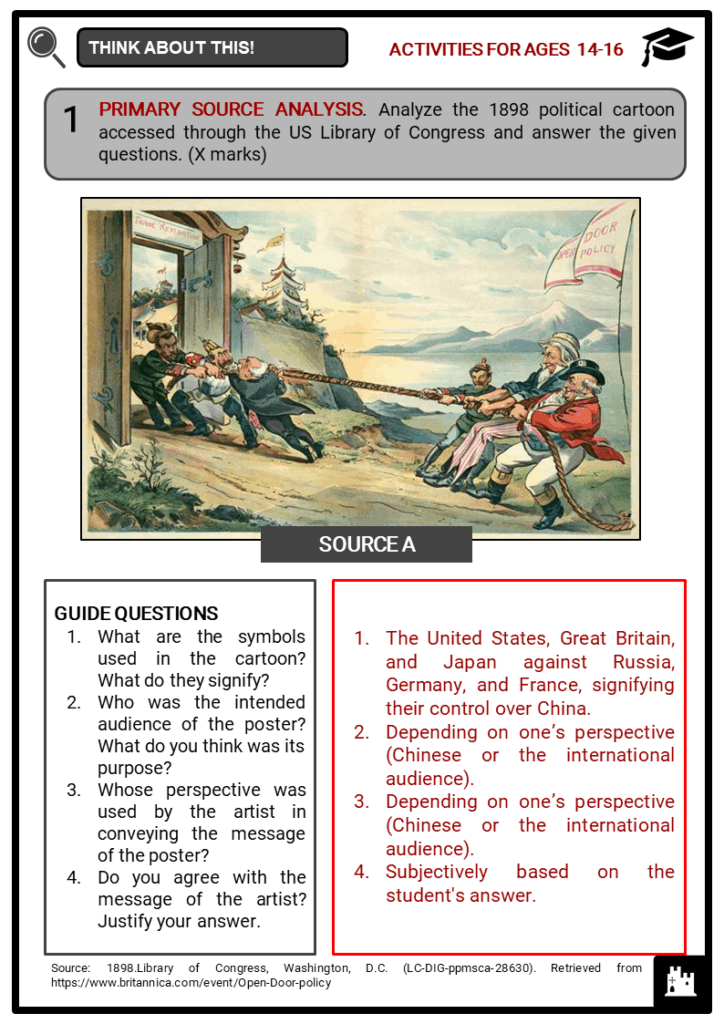Download China between 1900 and 1947 Worksheets
Do you want to save dozens of hours in time? Get your evenings and weekends back? Be able to teach China between 1900 and 1947 to your students?
Our worksheet bundle includes a fact file and printable worksheets and student activities. Perfect for both the classroom and homeschooling!
Table of Contents
Add a header to begin generating the table of contents
Summary
- Key events in China between 1900 and 1947
- Transition of China from a monarchy to a republic type of government
- Revolutionary leaders who shaped China's history
Key Facts And Information
Let’s learn more about China between 1900 and 1947!
China’s Leadership
- In 1900, China was ruled by the Qing family, better known as Manchu. During this time, China suffered a great deal, as it was heavily controlled by foreign nations who dictated how things were run.
- The 19th century was marred by the so-called “Opium Wars”, which involved Britain and France. China lost both of these wars, which brought the Chinese empire into question. The defeat of the Chinese by Britain was a great humiliation, as Britain’s army was small in comparison to the Chinese army. The grudge against foreigners was then accentuated by the Sino-Japanese conflict that took the Korean Peninsula from Chinese control.
- China also handed over the strategically important port of Hong Kong to Britain. More misery was imposed on China in 1894-95, when Japan attacked China, which then handed over China Korea, Formosa (present-day Taiwan), and Port Arthur. By the end of the 19th century, China had been occupied by most Western nations.
- There were numerous territorial encroachments on Chinese soil, and China was under the control of most European nations, Japan, Russia, and America.
- A major consequence of these wars was that China lost total control of its highly coveted seaports. Fifty of these ports were part of treaties, which meant that they were openings to Chinese lands being occupied for foreign trade. China was divided into spheres of influence, and it would effectively be governed by the nation that occupied that sphere. Thus, the wishes of the Chinese people fell on deaf ears.
- The occupiers, disregarding local traditions, caused resentment that grew daily. Kung-fu schools were a place where the people who resented the occupiers fueled their hatred. The kung-fu wrestlers represented the people who were from humble regions. Most of them were workers in the ports and feared to lose their jobs because of the steamships that were brought to China by Westerners. They believed that the discipline offered by kung-fu made them powerful and that the bullets of the enemy would have no effect on them.
The Rebellion
- The Taiping Rebellion
- The imperial family took the blame for the current situation in China. Their standing was not changed by the West’s invasion of China. There were uprisings against the Manchus, too. The most profound one was the Taiping Rebellion, which lasted from 1850 to 1864. Six hundred cities were destroyed, and as many as 20 million people were killed. Tracts of fertile land that China could not afford to lose were destroyed. The Manchus managed to restore their power with the help of the Europeans, but the hatred among the Chinese grew even more when the Manchus were back in power.
- In an attempt to curb the discontent in China, the Manchu family introduced a batch of reforms in 1898 known as the Hundred Days of Reform. These reforms were intended to help the country adapt to Western civilization.
- In this program, new schools and colleges would be set up to improve the educational system in China.
- The reforms would also help address the technological gap that had caused the two defeats to France and Britain.
- Corrupt officials present in the courts would be removed, and the financial structure of the government would be modernized and reformed.
- The reforms had to change virtually everything due to the general backwardness of the previous systems. This same modernization had already happened in Japan.
- However, these reforms to modernize China were never introduced. A rebellion led by Cixi, a former empress, prevented these reforms from being introduced. Therefore, China still maintained its status of being a nation under the control of European nations and of being led by a very conservative court. This court sabotaged the reforms, as they believed they would weaken the power of the Manchu dynasty. Soon after, a movement was formed to fight against those who ruled China. It was known as the Yi-Ho Tuan movement, meaning “The Boxers”.
- The Boxer Rebellion
- The elite amongst the Chinese people blamed the Europeans for the losses they had experienced in the Opium Wars, and many Chinese people began to share this opinion. It was perceived that the Europeans were running China through their domestic and foreign policies and that the situation was getting out of hand. A strong sense of nationalism swept over China toward the end of the 19th century, and many wanted to reclaim the lost glory of the Chinese. In 1898, these sentiments led to a rebellion.
- The rebellion started in Northern China, in the Shantung Province. This province was a German sphere of influence, and they dominated the railway lines, factories, and coal mines. The Germans profited at the expense of the Chinese, who were paid very poor wages and lived in poverty.
- Germans who lived in Shantung were murdered, as were other European missionaries. Chinese people who had converted to Christianity were also murdered. However, some Chinese who had converted to Christianity were involved in the massacres. More than 30,000 Chinese Christians were killed or tortured, including women and children. They were given the opportunity to save themselves by disowning Christianity, but few chose to renounce their faith.
- Those who instigated the Shantung rebellion belonged to a secret society called Yi Ho Tuan, meaning “Righteous Harmony Fists”. The rebellion started to spread across China, reaching the capital of Peking by 1900.
- The Manchu government was one of the targets of the rebellion. The Manchu government was under the rule of Empress Dowager. She had once been married to a former emperor and was very shrewd. China was a society where gender equality did not exist. She was a stand-alone case in a male-dominated society. Realizing what was going on, she made contact with the Boxers to offer them support. They accepted and turned their full attention to the Europeans.
- Many Europeans lived in the capital of Peking, and their lifestyle differed from those of the Chinese who lived in the city. The Chinese there were treated like slaves. Therefore, the Boxers found ready support there.
- By June, it became clear to the Europeans that their lives were in danger, and they were ready to leave the city. After attempting to complain, the German ambassador was seized and executed, sending out a very clear message.
- The rest of the Europeans crowded into the British Legation for safety, where they were defended by an assortment of 400 European soldiers. They lacked proper weapons but fought off the Boxers with great bravery.
- This Siege of the Legation lasted for 55 days, when an international force marching from Tientsin on the coast managed to help the stranded Europeans. Scores were injured, and some died.
- In retaliation, the international cohort went on the rampage in Peking, resulting in severe damage to the town. The Chinese government was ordered to pay $450 million in compensation for the damage they had done.
After the Rebellion
- When the Qing dynasty fell in 1911, warlords controlled different parts of China. Revolutionary leaders soon emerged from the rubble that was China.
- Yuan Shikai became the president of the country, but part of his plan was to restore the empire with him as the emperor. When he died in 1916, Sun Yat-sen regained control with the help of the Guomindang, a Nationalist party that sought assistance from foreign governments to defeat the warlords.
- Sun Yat-sen
- When the Chinese Revolution happened in 1911, Sun Yat-sen was in America, and the Manchu dynasty was overthrown. He quickly returned to China and was elected President of the United Provinces of China in January 1913 by an assembly in Nanking. He resigned in an attempt to make rival factions come together for the sake of the nation, but this failed, as China was now being run by warlords.
- Sun Yat-sen was a Nationalist revolutionary who believed China could only move forward in the early 1900s if the country became a republic and followed the Western ways in industry and agriculture. Unless they did this, he was convinced they would remain backward by Western standards. He believed in three principles: nationalism, democracy, and socialism. These beliefs were the backbone of the League of Common Alliance that Sun Yat-sen founded in 1898, which later became Guomindang.
- In 1922, Sun Yat-sen accepted the beliefs of the Guomindang so that they would be accepted by the Chinese Communist Party, which was founded in 1921. As a result, he got assistance from Russia and helped set up an effective structure for the Guomindang in Canton. He created a system of local Guomindang cells all over southern China so that the party would be more disciplined.
- Chiang Kai-shek
- Chiang Kai-shek was a leader of the Guomindang, and this helped him be considered as Sun Yat-sen’s successor. In 1926, he solidified his reputation when he went in search of the warlords of China.
- In September of 1928, a law was passed that gave Chiang Kai-shek dictatorial powers over China. Chiang was appointed president but did not have a hold over the whole nation because of its vast size and the fact that his army could not be in all parts of the nation at all times. In 1931, there was a Japanese invasion of Manchuria and an eventual attack on China in 1937.
- Mao Zedong
- Mao Zedong was born in 1893 and died in 1976. He is considered to be the father of Communist China. Alongside Sun Yat-sen and Chiang Kai-shek, he played a fundamental part in China.
The Long March
- This was a march that occurred in the autumn of 1933 and ended up saving Mao Zedong and the Communist Party. The Long March came about when the Chinese Communists had to flee an attack ordered by Chiang Kai-shek. The Red Army was an entity that Mao created, and it turned out to be his lifeline during the Long March. Without it, the Chinese Communist Party would have collapsed in the late 1920s and 1930s.
- The CPC (Communist Party of China) leaders were forced to flee to the Jiangxi hills as Chiang Kai-shek took control of Beijing. By 1931, the CPC members regrouped and formed the Jiangxi Soviet. At that time, the CPC had organized its armed forces, known as the Red Army.
- Chiang Kai-shek launched five extermination campaigns against the Jiangxi Soviet from 1930 to 1934.
- In the Long March, the Red Army, comprised of 100,000 soldiers, covered 10,000 km until they reached Shaanxi and settled in Yenan in 1935. It is said that 93,000 soldiers died, and this is the period when Mao Zedong gained leadership of the Red Army.
The Japan - China War
- This war began in July of 1937. Japan claimed Chinese troops attacked at the Marco Polo Bridge near Beijing. They launched a full-scale invasion of China, using the already-conquered Manchuria as a launching base for their army. The Chinese put up a fight, but they were up against a formidable enemy. China’s most important port, Shanghai, and Chiang Kai-shek’s capital, Nanking, fell in December of 1937.
- The occupation of Manchuria by the Soviet Army forced the Japanese to surrender in 1946. When the Soviets withdrew from the region, the Nationalists occupying Mukden and the Communists occupying northern Manchuria scrambled for control of the area. When the Nationalists occupied Changchun, the northeast part of the region, a 15-day truce was held from June 6 - June 22. Meanwhile, fighting took place in different areas of China.
- By 1946, a full-scale war erupted between Chiang Kai-shek’s Nationalist government (Guomindang) and Mao Zedong’s Communist Party.

